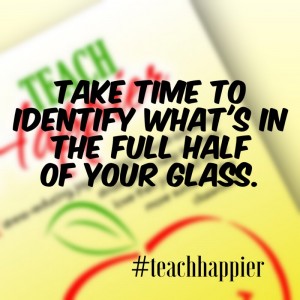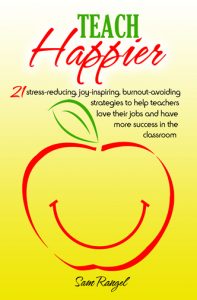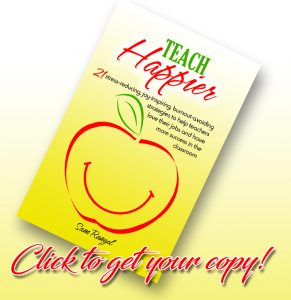Originally posted on SuccessInTheClassroom.com
The bell finally rings, and not a second too soon. You say the words, “OK class, have a great day. See you tomorrow,” but you really don’t want to see them tomorrow, especially after today. Right?
You had THAT class today, and you’re ready to say some words that are not really appropriate for school. You’re mad. You’re frustrated. You’re stressed. I know. I’ve been there. We’ve all had those days.

Your happiness is missing in action, and you want it back. You need it back. You don’t want to go home and bring that frustration to your family. It’s not fair to them. Right?
Here are 5 steps that you can take to bring your happiness back. I have to warn you, however, these steps are not for the weak. These steps take some guts. Most teachers won’t want to take these steps. They’ll want to stay upset and stressed. You’re not like most teachers, however. You need to do whatever it takes to fight the desire to stay stressed. You are an amazing teacher. You can do this. Right?
Ready?
Here are the 5 Really Tough Steps to Bring Happiness Back After THAT Class:
Identify everything that went – RIGHT.
I bet if I asked you to make a list of all that went WRONG today, you would find it very easy to do. That is because our brains will naturally focus on the negative. It’s part of our brain’s defense mechanism. What I’m asking you to do in this step is to stop listening to the little voice in your head that has you thinking of all that went WRONG, and take some time and identify all that went RIGHT today. That’s tough. It’s actually unnatural for us to do that, especially when we’re stressed. Making the choice to look for the good is a tough thing to do when you’re frustrated, but you are an amazing teacher. You can do this. Take out a piece of paper or use your whiteboard, and make a list of what went RIGHT today. The drive to work was pleasant. Mary turned in her homework for the first time. The computer didn’t freeze while you were using it. The room was clean when you walked in. The sun was out. The air conditioner worked. You get the idea. You’ll realize that once you get started, you’ll find that although there were many things that went WRONG, there were much more things that went RIGHT.
Rewrite your Blame Page.
This step is a really tough one for a lot of teachers, but not you. You got this.
When you look back at your rough day, it’s easy to place blame on students, colleagues, unexpected events, etc. I know when I had THAT class, I would blame certain students in THAT class for my bad day. If only Johnny was absent today, it would have been a good day. If only Briana was more focused, it would have been a good day. If only I didn’t have so many students with really low skills in my class, it would have been a good day. We all have a Blame Page. This is where we list all the people, events, and circumstances that keep us from having the good day that we desire. What I’m asking you to do with this step is to rewrite your Blame Page and take everybody and everything off that list, except for one name. Yours.
Yes, Johnny was a knucklehead again. Yes, the teacher’s aide didn’t show up today. Yes, the technology in the classroom didn’t work, and we have every right to blame our bad day on these, but don’t. Take them off your Blame Page and ask yourself, “What did I do (or not do) to cause me to have this bad day?”
“That’s tough, Sam.”
I know, but it’s the question that amazing teachers ask themselves every time they plans don’t work out like they expected. By accepting responsibility for today’s disaster, you allow your brain to begin to start figuring out what needs to change for tomorrow, and that change will begin with you. I should have planned a better lesson. I should have put Johnny in a seat away from his friend. I should have contacted Briana’s mother about her lack of focus. By remaining upset or stressed, you don’t allow your brain to do its creative magic. This is a tough step, but taking it will allow you to have a better day tomorrow and make today easier to put behind you.
Smile.
I know you’re saying that this is really not a tough step to take. Smiling is easy. Right? Well, when you find yourself so frustrated after THAT class that you’re ready to strangle someone, smiling is not something that you want to do. It will be tougher than you realize. Still, making the effort to smile in the middle of your frustration has a natural effect of easing that frustration and bringing a little bit of your happiness back. There’s a natural connection with smiling and your brain’s releasing of the chemicals that promote happiness. When we smile, even if it’s a fake smile, we trick the brain into giving us a dose of the happy chemicals. Give it a try. The next time THAT class is getting your nerves, smile. Better yet, smile at the class. They might think you’re crazy, but that’s OK. Go ahead and fake it. Even an ingenuous smile has the effect of bringing a dose happiness into your day.
Practice grateful breathing.
“What is grateful breathing, Sam?” I’m glad you asked. We’ve all heard how when you’re stressed or frustrated, we need to just breathe. Right? I hate when people tell me that, especially when I’m upset. I don’t want to “just breathe.” I want to just throw something.
This is why this step is particularly difficult as well. We don’t want to breathe. We want to say something inappropriate. Still, we know that breathing exercises are beneficial to help reduce stress.
Grateful breathing is taking it to the next level and not only reducing stress, but inviting happiness into our day. Here’s what you do: You take a long breath in though your nose, then exhale slowly out your mouth. The key to grateful breathing is to finish exhaling by saying the words, “Thank you.” This step works best if you have already taken step 1 – Identify everything that went RIGHT. You can begin to think about your list of good things, and be grateful for them as you breathe out. This won’t be easy for most teachers. They’ll want to stay mad, and look out if you happen to run into them after THAT class. You’re not like most teachers. You are amazing, and I am grateful for you.
Make someone’s day.
Of all the steps mentioned in this post, this step is the most difficult. This step asks you to stop thinking about your own situation and focus on the situation of others. After you’ve had THAT class, you are dealing with a lot of negative emotions, and you would love it if someone would come into your room and just give you a hug or at least allow you to vent. When we’re feeling stressed or frustrated, we like going to our best friend and telling him/her all about it. We lay it all out there (whether they want to hear it or not.) It’s because we want to feel better. We want to be happy again. That is natural.
What isn’t natural is making the decision – in the middle of our frustration – to make someone else happy.
I like using this step as a weapon against my stress.
It’s not easy. In fact the last time I used it was only because my wife – who I was venting to at the time – made me do it. I was on the phone complaining to her about what had made me upset, and she listened quietly until I was finished. The she said, “Now go do something nice for someone.” I have to admit, that was not the response I was expecting. So, as hard as it was to stop brooding about what I was experiencing, I obeyed my wife’s instructions and walked into a teacher’s classroom and pointed at her and said, “Just want you to know…I think you’re amazing. Just sayin’.” It wasn’t much, but when she smiled and thanked me, I know it made her day, and as a result, I couldn’t help but smile. It was awesome. Happiness returned, and life was good again.
We all have THAT class or THOSE days. They just happened. Right.
We don’t have to let them steal our happiness or keep us stressed. I’ve learned that there are steps that we can take to take back control of our emotions and teach and live happier. These are just five, and they’re probably the toughest steps to take, but if you are committed to not letting THAT class ruin your day, these steps will help bring happiness back.
I hope you found this post valuable. You can find more strategies to invite more happiness into your days in my book, Teach Happier – 21 stress-reducing, joy-inspiring, burnout-avoiding strategies to help teachers love their jobs and have more success in the classroom.
Do you know a teacher who might benefit from this post? Please share by clicking on the Social Media icons below.
Until next time, here’s to your Success in the Classroom!
Thank you,
Sam





